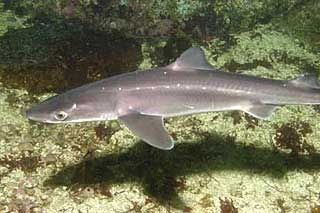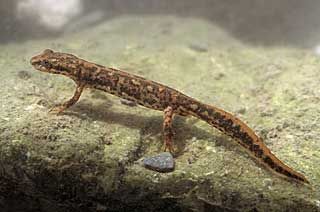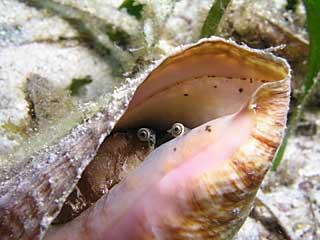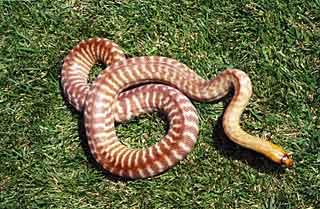These posts are licensed under the GNU Free Documentation License.
They mostly use material from Wikipedia.
 DescriptionThe Sri Lanka Frogmouth (Batrachostomus moniliger) is a relatively small frogmouth. The frogmouths are a group of tropical nocturnal birds related to the nightjars.
DescriptionThe Sri Lanka Frogmouth (Batrachostomus moniliger) is a relatively small frogmouth. The frogmouths are a group of tropical nocturnal birds related to the nightjars.
This species is found only in southwest India and Sri Lanka. Its habitat is dense tropical forest. A single white egg is laid in the fork of a tree and incubated by the female at night and the male in the day.
The Sri Lanka Frogmouth is about 23cm long. It looks large-headed, and has a large flattened hooked bill and huge frog-like gape. The female is rufous, lightly spotted with white. The male is grey and more heavily spotted.
Like other frogmouths, this species rests horizontally on branches during the day, camouflaged by its cryptic plumage. At night, it hunts insects with its large gape. The flight is weak.
The Sri Lanka Frogmouth is best located at night by its song, which is a loud bubbling laugh.
 DescriptionThe Giant Salamanders (Cryptobranchidae) are aquatic amphibians found in brooks and ponds in Japan, China and with a similar specimen in the United States. They grow up to 1.8 meters in length, though most individuals found today are considerably smaller.
DescriptionThe Giant Salamanders (Cryptobranchidae) are aquatic amphibians found in brooks and ponds in Japan, China and with a similar specimen in the United States. They grow up to 1.8 meters in length, though most individuals found today are considerably smaller.
During mating season, these salamanders will travel upstream where, after the fertilization of the eggs, the male will guard them for at least six months. At this point, the offspring will live off their noticeable stored fat until ready to hunt.
The giant salamander has been given a place in mythology. In one particular Asian myth, the salamander, although resembling a typical specimen, it makes its home in fires; the hotter the better. Early travelers to China were shown garments which, or so they were told, had been woven of wool from the salamander: the cloth was completely unharmed by fire. The garments had actually been woven from asbestos.
* Genus Andrias (Giant Salamanders)** Chinese Giant Salamander (Andrias davidianus)** Japanese Giant Salamander (Andrias japonicus)* Genus Cryptobranchus (Hellbenders)** Hellbender (Cryptobranchus alleganiensis )
The Swiss physician Johann Jacob Scheuchzer described in 1726 a fossil as Andrias scheuchzeri (Andrias means "image of man"). He assumed that it was a fossil of a human being that survived the Great Flood, and called it Homo diluvii testis (Witness of the Great Flood). The Teylers Museum in Haarlem (the Netherlands) bought the fossil in 1802, where it still is being exhibited. In 1812 the fossil was examined by Georges Cuvier who recognized it as being a Giant Salamander. The name of the genus Andrias was used for the Chinese and Japanese Giant Salamander.
Invertebrate: Dlinza Forest Pinwheel
 DescriptionDlinza Forest Pinwheel (Trachycystis clifdeni) is a Critically Endangered snail known only from Dlinza forest, South Africa. The forest is protected under KwaZulu-Natal Wildlife, however, it is a very small area (only 250 hectares) within an urban location and there is concern that the species may be negatively impacted by extreme stochastic weather conditions and climate change.
DescriptionDlinza Forest Pinwheel (Trachycystis clifdeni) is a Critically Endangered snail known only from Dlinza forest, South Africa. The forest is protected under KwaZulu-Natal Wildlife, however, it is a very small area (only 250 hectares) within an urban location and there is concern that the species may be negatively impacted by extreme stochastic weather conditions and climate change.
photo © Dai G. Herbert
 DescriptionThe Javan Rhinoceros (Rhinoceros sondaicus) is one of the rarest and most endangered large mammals anywhere in the world. According to 2002 estimates, only about 60 remain alive, in Indonesia and Vietnam. Even these tiny populations are still being poached and the outlook for the species is grim.
DescriptionThe Javan Rhinoceros (Rhinoceros sondaicus) is one of the rarest and most endangered large mammals anywhere in the world. According to 2002 estimates, only about 60 remain alive, in Indonesia and Vietnam. Even these tiny populations are still being poached and the outlook for the species is grim.
The Javan Rhinoceros occupied lowland rainforests through much of South-east Asia. It is grey in color, hairless, and adults typically weigh up to 1.4 tonnes. Like the closely related larger Indian Rhinoceros, it has only one horn, and in common with the almost equally endangered Sumatran Rhinoceros it is exclusively a browser on leaves rather than a grazer on grasses. Favoured feeding strategies include knocking down saplings to reach the leaves and shoots, and gathering fruit.
Status: Classified as Critically Endangered (CR-C2a) by the IUCN Red List 2002, and listed under Appendix I of CITES.
 DescriptionBurying beetles or sexton beetles (genus Nicrophorus) are the best-known genus within the family Silphidae of carrion beetles. Most of these beetles are black with red markings on the elytra (forewings). They bury dead birds and rodents in order to lay their eggs into the carrion. Adults take care of the brood.
DescriptionBurying beetles or sexton beetles (genus Nicrophorus) are the best-known genus within the family Silphidae of carrion beetles. Most of these beetles are black with red markings on the elytra (forewings). They bury dead birds and rodents in order to lay their eggs into the carrion. Adults take care of the brood.
Burying beetles have large chemoreceptors at the tips of their antennae, capable of detecting a dead animal from a long way away. After finding a carcass (most likely that of a small bird or a mouse), beetles fight amongst themselves (males fighting males, females fighting females) until the winning pair remain. If a lone beetle finds a carcass, it can continue alone and await a partner.
Status: Classified as Critically Endangered (CR - A1c) on the IUCN Red List 2002.
 Description:The Keeled Box Turtle (Pyxidea mouhotii) inhabits the forest floor leaf litter of localized areas of evergreen forests from northeastern India through Myanmar, Lao PDR and Viet Nam to southern China. The species has been harvested in large numbers for the Asian turtle consumption trade, as well as for the international pet trade. Populations have disappeared and remaining populations, including those in formally designated protected areas, appear to be declining.photo © Peter Paul van Dijk
Description:The Keeled Box Turtle (Pyxidea mouhotii) inhabits the forest floor leaf litter of localized areas of evergreen forests from northeastern India through Myanmar, Lao PDR and Viet Nam to southern China. The species has been harvested in large numbers for the Asian turtle consumption trade, as well as for the international pet trade. Populations have disappeared and remaining populations, including those in formally designated protected areas, appear to be declining.photo © Peter Paul van Dijk
 DescriptionThe Spiny Dogfish is a type of small shark and one of the best known of the dogfish. There are actually several species to which the name is applied, but all are readily distinguished by their having two spines, one in front of each dorsal fin, and their lack of an anal fin. They are members of the family Squalidae in the order Squaliformes.
DescriptionThe Spiny Dogfish is a type of small shark and one of the best known of the dogfish. There are actually several species to which the name is applied, but all are readily distinguished by their having two spines, one in front of each dorsal fin, and their lack of an anal fin. They are members of the family Squalidae in the order Squaliformes.
The most widespread of the spiny dogfish is the grey-speckled Squalus acanthus, the common spiny (or piked) dogfish, which is found in shallow waters in most parts of the world. It can grow to around 60 cm in length and weighs about 2-3 kg. It particularly prefers temperate waters and migrates seasonally to find water of a comfortable temperature. It feeds on small fish and invertebrates, and can be present in such great numbers that it can seriously impact commercial fisheries. Spiny dogfish are themselves fished for food in Europe. In England, where they are particularly popular, they are often referred to as "woof". They are also somewhat euphemistically known as "rock salmon" or "rock eels".
Status: Classified as Lower Risk – near threatened (LR/nt) over the whole of its range on the IUCN Red List 2004.
 DescriptionThe Andean Flamingo (Phoenicopterus andinus) is a bird species in the Flamingo family restricted to the Chilean Andes. It is closely related to James's Flamingo.
DescriptionThe Andean Flamingo (Phoenicopterus andinus) is a bird species in the Flamingo family restricted to the Chilean Andes. It is closely related to James's Flamingo.
Like all flamingos it lays a single chalky white egg on a mud mound. Its population in Northern Chile was badly hit hit by drought, which cause the breeding lagoon areas to dry up, either preventing nest building, or allowing predation especially from the Culpeo Fox, Pseudalopex culpaeus.
Andean Flamingos, like all the group, feed by filtering small items from water with their specialised bills. They have a deep, narrow lower mandible, which allows them to eat small foods such as diatoms, in contrast to the wider bill of larger species, which take bigger prey items.
Most of the plumage is pinkish white. The Andean Flamingo is the only species that has yellow legs and feet.
Status: Classified as Vulnerable (VU – A1acd+2bcd) on the IUCN Red List 2002.
 DescriptionIt has long been known that the African and Asian elephants are separate species. African elephants tend to be larger than the Asian species (up to 4 m high and 7500 kg) and have bigger ears (which are rich in veins and thought to help in cooling off the blood in the hotter African climate). Female African elephants have tusks, while female Asian Elephants do not. African elephants have a dipped back, as compared with the Asian species, and have two "fingers" at the tip of their trunks, as opposed to only one.
DescriptionIt has long been known that the African and Asian elephants are separate species. African elephants tend to be larger than the Asian species (up to 4 m high and 7500 kg) and have bigger ears (which are rich in veins and thought to help in cooling off the blood in the hotter African climate). Female African elephants have tusks, while female Asian Elephants do not. African elephants have a dipped back, as compared with the Asian species, and have two "fingers" at the tip of their trunks, as opposed to only one.
There are two populations of African elephants, Savannah and Forest, and recent genetic studies have led to a reclassification of these as separate species, the forest population now being called Loxodonta cyclotis, and the Savannah (or Bush) population termed Loxodonta africanus. This reclassification has important implications for conservation, because it means where there were thought to be two small populations of a single endangered species, there may in fact be two separate species, each of which is even more severely endangered. There's also a potential danger in that if the forest elephant isn't explicitly listed as an endangered species, poachers and smugglers might thus be able to evade the law forbidding trade in endangered animals and their body parts.
Status: Classified as Endangered (EN - A1b) on the IUCN Red List 2002.(technorati tags: nature, conservation, elephants, animals)
 DescriptionThe Sardinian brook newt has a slender body with a flattened head; the tail is low and oval in cross-section. The upper jaw overhangs the lower, and the lips are well developed. The extremities are slender and the front leg carries four, and the hind leg five, toes; males have a small spur on the hind legs. The male cloaca is hook-shaped, whilst that of the female is more or less cone-shaped.
DescriptionThe Sardinian brook newt has a slender body with a flattened head; the tail is low and oval in cross-section. The upper jaw overhangs the lower, and the lips are well developed. The extremities are slender and the front leg carries four, and the hind leg five, toes; males have a small spur on the hind legs. The male cloaca is hook-shaped, whilst that of the female is more or less cone-shaped.
The skin is relatively smooth, with a few unevenly distributed warts. Coloration is variable; the upper surface may be grey, brown or olive, with variable numbers of brown, green, red or black spots along the back. The underside is frequently yellowish or reddish, particularly along the centre of the belly, and usually dark spotted, especially in males. The throat is usually spotted, and there is a white, yellowish, bright-brown, rust-brown or dark-brown stripe along the backbone.
Status: Classified as Critically Endangered (CR - A1ac, B1+2bcd) on the IUCN Red List 2002.
 DescriptionThe Queen Conch (Strombus gigas) is a true conch and the largest mollusk native to North America. It can grow to 15-31 cm, 6-12" in length.
DescriptionThe Queen Conch (Strombus gigas) is a true conch and the largest mollusk native to North America. It can grow to 15-31 cm, 6-12" in length.
The Queen Conch lives in the wider Caribbean region including Mexico, southern Florida, and the Bahamas, north to Bermuda. It lives in seagrass meadows and on sandy substrate feeding on detritus, macroalgae, and epiphytes. The nacre of its shell blushes a sunrise of pink, yellow, peach and cream colors.
Other names for the Queen Conch include pink conch, caracol reina, caracol rosa, caracol rosado, caracol de pala, cobo, botuto, guarura, and lambi.
Status: Listed on Appendix II of CITES.
(technorati tags: invertebrate, conch, wildlife, animals, environment)
 DescriptionThe woma python is distinguished from other Australian pythons by its narrow head which is barely distinct from the neck. It has small eyes, smooth scales, a broad body and a thin tail. This species is coloured grey, olive, brown or rich red-brown above, with several darker olive, brown to black cross-bands on the body. The sides are paler and the underside is a cream to yellow colour, with pink or brown blotches. The woma python and its relative the black-headed python, do not have heat sensitive pits bordering the mouth like other pythons.
DescriptionThe woma python is distinguished from other Australian pythons by its narrow head which is barely distinct from the neck. It has small eyes, smooth scales, a broad body and a thin tail. This species is coloured grey, olive, brown or rich red-brown above, with several darker olive, brown to black cross-bands on the body. The sides are paler and the underside is a cream to yellow colour, with pink or brown blotches. The woma python and its relative the black-headed python, do not have heat sensitive pits bordering the mouth like other pythons.
This species is found in the Australian interior, from central Australia into the south-western edge of Queensland, and into northern South Australia.
Status: Classified as Endangered (EN A1c) on the IUCN Red List 2000, and listed on Schedule 4 (Specially Protected Fauna) of the Western Australian Wildlife Conservation Act.(technorati tags: reptiles, python, wildlife, animals, environment)














